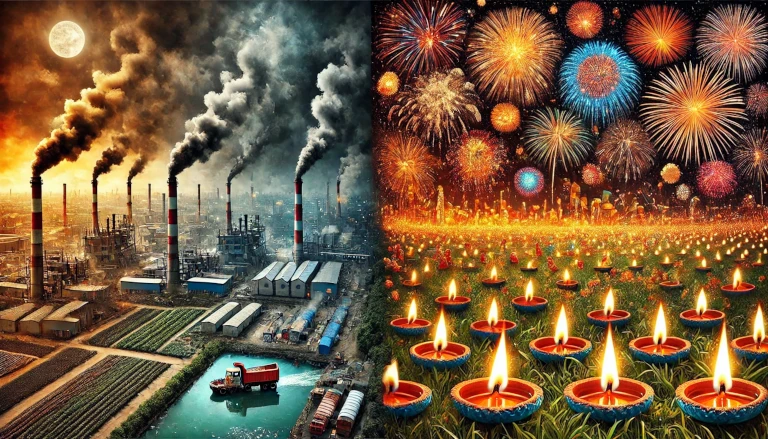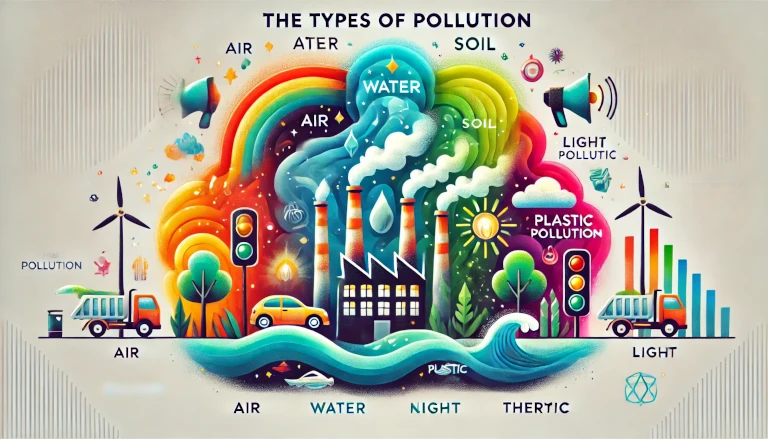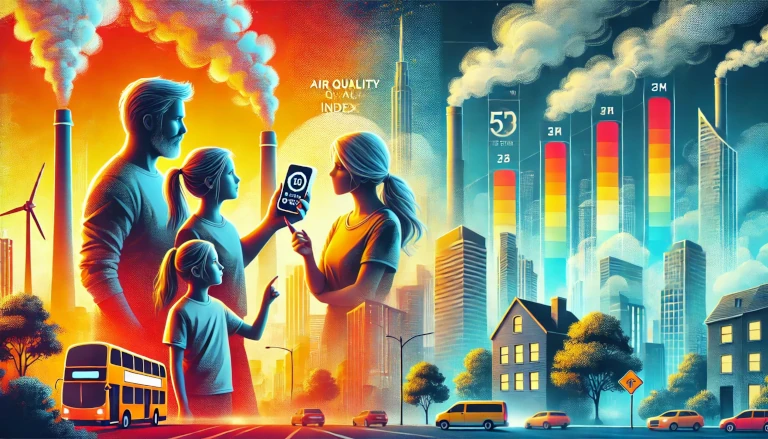While Diwali firecrackers do contribute to air pollution, the percentage of pollution they cause is significantly smaller when compared to other sources like war-related activities, mining, aviation, and greenhouse gases. Let’s break down these points with supporting data and comparisons.
Before Proceeding further and to make any final conclusion also read “Top 10 Pollution Causing Activities: How They Impact Our Environment”
Comparing Diwali Firecracker Pollution with Year-Round Pollution Due to Other Sources 🚨💨
Diwali, the festival of lights, is traditionally celebrated with fireworks, but the pollution caused by firecrackers has become a significant concern in recent years. However, to better understand the environmental impact of Diwali firecrackers, it is essential to compare this temporary spike in pollution with year-round pollution from other sources such as wars, mining, and industrial activities. This comparison sheds light on how different activities contribute to air pollution, and why sustainable practices are necessary, both during festive seasons and throughout the year.
Understanding Diwali Firecracker Pollution 🎆
During Diwali, firecracker use leads to a temporary but sharp increase in air pollution, particularly in India. Firecrackers emit harmful pollutants such as PM2.5, PM10, carbon dioxide (CO2), sulfur dioxide (SO2), and nitrogen oxides (NOx). These pollutants severely impact air quality, particularly in densely populated urban areas.
Key Impacts of Firecracker Pollution:
- Short-Term Air Quality Deterioration: Air quality levels in cities like Delhi, Mumbai, and Kolkata often drop into the “severe” category during Diwali due to the spike in PM2.5 levels.
- Health Hazards: Exposure to elevated levels of pollutants during Diwali can exacerbate respiratory issues, allergies, and cardiovascular diseases, especially in children and the elderly.
While Diwali-related pollution lasts for a few days, its impact on public health and the environment can linger for longer. But how does it compare to pollution caused by year-round activities like mining, wars, and industrial operations?
Pollution from War and Military Operations 💣
Wars and military activities are major sources of environmental degradation and pollution. Conflict zones see significant air, water, and soil contamination, as well as deforestation and destruction of ecosystems.
Key Pollutants from War:
- Explosives and Ammunition: Military explosives emit harmful gases, including CO2, NOx, and sulfur compounds, which contribute to air pollution.
- Burning of Fossil Fuels: Military vehicles, aircraft, and ships consume large amounts of fossil fuels, releasing vast quantities of CO2 and particulate matter.
- Chemical and Biological Warfare: The use of chemical weapons can leave lasting contamination in affected areas, causing severe health risks for both combatants and civilians.
Long-Term Impact:
- Environmental Destruction: Wars can lead to deforestation, soil degradation, and water pollution, causing long-term damage to ecosystems.
- Human Health: Populations exposed to pollutants from military activities may experience long-term health problems, including respiratory and cardiovascular diseases, and birth defects.
While firecracker pollution from Diwali is seasonal and localized, the pollution from wars and military activities can have far-reaching and long-lasting effects on the environment and human health.
Mining and Industrial Pollution ⚒️🏭
Mining operations and industrial activities are year-round contributors to air, water, and soil pollution. The extraction of minerals and fossil fuels, as well as the emissions from industries, release large amounts of pollutants into the environment.
Key Pollutants from Mining and Industry:
- Particulate Matter (PM): Dust and particulate matter are released during mining and construction activities, contributing to air pollution.
- Toxic Metals: Mining operations can release heavy metals like lead, mercury, and arsenic, contaminating water sources and soil.
- Carbon Dioxide (CO2): Industrial plants burn fossil fuels, emitting significant quantities of CO2, one of the main drivers of climate change.
Long-Term Impact:
- Habitat Destruction: Mining and industrial activities can lead to the destruction of forests and wildlife habitats, causing biodiversity loss.
- Water Pollution: Mining often contaminates local water bodies with heavy metals, affecting aquatic life and human populations dependent on these water sources.
While Diwali firecracker pollution is intense but temporary, the pollution from mining and industrial activities is continuous and contributes to long-term environmental degradation. However, unlike firecrackers, which are primarily a cultural practice, mining and industry are vital to economic growth, making it more challenging to regulate.
Diwali Firecrackers vs. Year-Round Pollution: A Comparison 📊
- Duration and Frequency:
- Diwali Firecracker Pollution: A short-term spike lasting a few days, typically once a year.
- Pollution from War, Mining, and Industry: Continuous year-round pollution that contributes to long-term environmental degradation.
- Pollutants Released:
- Firecrackers: Release PM2.5, PM10, CO2, NOx, and sulfur compounds, contributing to respiratory diseases and poor air quality.
- War, Mining, and Industry: Release toxic metals, CO2, NOx, and sulfur compounds, leading to water and soil contamination, biodiversity loss, and long-term public health concerns.
- Health Impact:
- Diwali Firecrackers: Increased respiratory and cardiovascular issues during the festival period.
- War, Mining, and Industry: Long-term exposure to toxins leads to chronic health conditions and higher mortality rates.
- Environmental Impact:
- Firecrackers: Temporary reduction in air quality but relatively low long-term environmental impact.
- Other Sources: Long-lasting damage to ecosystems, biodiversity, and natural resources.
Balancing Cultural Traditions with Sustainability 🌱
While pollution from Diwali firecrackers is a pressing concern, it’s important to recognize that they are a part of a cultural tradition that can be managed through sustainable alternatives like eco-friendly fireworks, laser shows, and LED lights. In contrast, pollution from sources like mining and industrial activities requires significant policy changes and technological advancements to mitigate.
Steps to Reduce Diwali Firecracker Pollution:
- Use Eco-Friendly Crackers: Opt for fireworks that release fewer harmful chemicals and produce less smoke.
- LED Lighting: Decorate homes with energy-efficient LED lights instead of firecrackers.
- Community Celebrations: Participate in community light shows and eco-friendly festivities that reduce the need for personal fireworks.
Scientific Evidence
- PM Emissions from Firecrackers: A study conducted by the Indian Institute of Technology (IIT) Kanpur showed that Diwali-related firecracker pollution is responsible for a short-term rise in PM2.5 concentrations but contributes only a small percentage to the total annual pollution load.
- Global Comparisons: In contrast, a report by the International Energy Agency (IEA) shows that the global energy sector emits around 33 billion tons of CO2 annually. Similarly, industrial and vehicular emissions contribute far more in terms of both scope and duration than the transient impact of firecrackers during Diwali.
While Diwali firecracker pollution is often highlighted during the festive season, it’s important to compare it with the more pervasive and year-round pollution caused by wars, mining, and industrial activities. Addressing firecracker pollution can lead to immediate improvements in air quality, but long-term efforts to reduce pollution from other sources are essential for creating a sustainable future.
Discover more from Green Ecosystem - Renewable Energy, Agriculture, and Environmental Sustainability
Subscribe to get the latest posts sent to your email.


